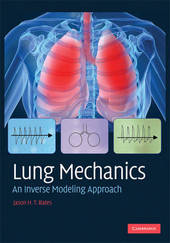
|
Lung Mechanics: An Inverse Modeling Approach
Hardback
Main Details
| Title |
Lung Mechanics: An Inverse Modeling Approach
|
| Authors and Contributors |
By (author) Jason H. T. Bates
|
| Physical Properties |
| Format:Hardback | | Pages:236 | | Dimensions(mm): Height 253,Width 180 |
|
| Category/Genre | Physiology |
|---|
| ISBN/Barcode |
9780521509602
|
| Classifications | Dewey:612.2 |
|---|
| Audience | | Professional & Vocational | |
|---|
|
Publishing Details |
| Publisher |
Cambridge University Press
|
| Imprint |
Cambridge University Press
|
| Publication Date |
30 July 2009 |
| Publication Country |
United Kingdom
|
Description
With mathematical and computational models furthering our understanding of lung mechanics, function and disease, this book provides an all-inclusive introduction to the topic from a quantitative standpoint. Focusing on inverse modeling, the reader is guided through the theory in a logical progression, from the simplest models up to state-of-the-art models that are both dynamic and nonlinear. Key tools used in biomedical engineering research, such as regression theory, linear and nonlinear systems theory, and the Fourier transform, are explained. Derivations of important physical principles, such as the Poiseuille equation and the wave speed equation, from first principles are also provided. Example applications to experimental data throughout illustrate physiological relevance, whilst problem sets at the end of each chapter provide practice and test reader comprehension. This book is ideal for biomedical engineering and biophysics graduate students and researchers wishing to understand this emerging field.
Author Biography
Jason H. T. Bates is currently a Professor of Medicine and Molecular Physiology & Biophysics in the University of Vermont College of Medicine, and a Member of the Pulmonary Division at Fletcher Allen Health Care. He is also a member of the American Physiological Society, the American Thoracic Society, the Biomedical Engineering Society, and an elected senior member of the IEEE Engineering in Medicine and Biology Society. Dr Bates has published more than 190 peer-reviewed journal papers in addition to numerous book chapters, conference abstracts, and other articles. In 1994 he was awarded the Doctor of Science degree by Canterbury University, and in 2002 he was elected a Fellow of the American Institute for Medical and Biological Engineering.
Reviews'In a clearly written language, Jason Bates provides a grand tour into the frontiers of the bioengineering of lung mechanics and physiology. The reader is elegantly led through the intricacy and beauty of forward and inverse modeling applied to the lung with plenty of examples for the physiologist, problems for the teacher, insight for the scientist and even some food for the philosophically oriented.' Bela Suki, Boston University 'This book aims to provide physiologists and medical professionals interested in lung mechanics an understanding of the mathematics behind modeling. In my view, Jason Bates has succeeded. While the depth of the mathematics may be daunting, the explanations are clear and Jason takes the readers by the hand and leads them gently through the maze, arriving on the other side enlightened! No where is this more obvious than I the chapter on the derivation of the constant phase model and hysteresivity. These have become family names to modern respiratory physiologists; however, I would venture that the majority who use them do not understand them. Reading Jason's book allows a much greater understanding of these and other common concepts in modeling the mechanical behaviour of the lungs. I recommend this to all currently in the field and those wanting to enter. Well done!' Peter Sly, Telethon Institute for Child Health Research 'In a clearly written language, Jason Bates provides a grand tour into the frontiers of the bioengineering of lung mechanics and physiology. The reader is elegantly lead through the intricacy and beauty of forward and inverse modeling applied to the lung with plenty of examples for the physiologist, problems for the teacher, insight for the scientist and even some food for the philosophically oriented.' Bela Suki, Boston University 'This is a very well-written book which fulfills a major need for a thorough and quantitative analysis of respiratory mechanics. Moreover, Dr Bates does a superb job at simplifying rigorous applied mathematical theory such that practicing clinicians and life scientists with little to no mathematical training can be proficient in concepts that have traditionally been the domain of graduate-level engineers and physicists.' David W. Kaczka, Johns Hopkins University 'This long-needed textbook identifies and then bridges the gap between the classical views on lung mechanics and the experimental evidence; an enormous help for students and a valuable teaching resource for lecturers and senior researchers.' Zoltan Hantos, University of Szeged, Hungary
|